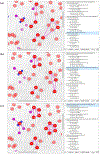KPDGUI: An interactive application for optimization and management of a virtual kidney paired donation program
- PMID: 31054501
- PMCID: PMC6538268
- DOI: 10.1016/j.compbiomed.2019.03.013
KPDGUI: An interactive application for optimization and management of a virtual kidney paired donation program
Abstract
Background and objectives: The aim in kidney paired donation (KPD) is typically to maximize the number of transplants achieved through the exchange of donors in a pool comprising incompatible donor-candidate pairs and non-directed (or altruistic) donors. With many possible options in a KPD pool at any given time, the most appropriate set of exchanges cannot be determined by simple inspection. In practice, computer algorithms are used to determine the optimal set of exchanges to pursue. Here, we present our software application, KPDGUI (Kidney Paired Donation Graphical User Interface), for management and optimization of KPD programs.
Methods: While proprietary software platforms for managing KPD programs exist to provide solutions to the standard KPD problem, our application implements newly investigated optimization criteria that account for uncertainty regarding the viability of selected transplants and arrange for fallback options in cases where potential exchanges cannot proceed, with intuitive resources for visualizing alternative optimization solutions.
Results: We illustrate the advantage of accounting for uncertainty and arranging for fallback options in KPD using our application through a case study involving real data from a paired donation program, comparing solutions produced under different optimization criteria and algorithmic priorities.
Conclusions: KPDGUI is a flexible and powerful tool for offering decision support to clinicians and researchers on possible KPD transplant options to pursue under different user-specified optimization schemes.
Keywords: Fallback options; Kidney paired donation; Optimization; Simulation models; User interfaces.
Copyright © 2019 Elsevier Ltd. All rights reserved.
Conflict of interest statement
Conflict of Interest Statement
MA Rees is the founder and CEO of the Alliance for Paired Donation. The authors have no other conflicts of interest to disclose.
Figures





Similar articles
-
Graph-based optimization algorithm and software on kidney exchanges.IEEE Trans Biomed Eng. 2012 Jul;59(7):1985-91. doi: 10.1109/TBME.2012.2195663. Epub 2012 Apr 20. IEEE Trans Biomed Eng. 2012. PMID: 22542649
-
Planning for Uncertainty and Fallbacks Can Increase the Number of Transplants in a Kidney-Paired Donation Program.Am J Transplant. 2015 Oct;15(10):2636-45. doi: 10.1111/ajt.13413. Epub 2015 Aug 4. Am J Transplant. 2015. PMID: 26372837 Free PMC article.
-
Kidney paired donation: principles, protocols and programs.Nephrol Dial Transplant. 2015 Aug;30(8):1276-85. doi: 10.1093/ndt/gfu309. Epub 2014 Oct 7. Nephrol Dial Transplant. 2015. PMID: 25294848 Review.
-
Valuing Sets of Potential Transplants in a Kidney Paired Donation Network.Stat Biosci. 2018 Apr;10(1):255-279. doi: 10.1007/s12561-018-9214-7. Epub 2018 Mar 1. Stat Biosci. 2018. PMID: 30220933 Free PMC article.
-
Four years of experience with the Australian kidney paired donation programme.Nephrology (Carlton). 2015 Mar;20(3):124-31. doi: 10.1111/nep.12369. Nephrology (Carlton). 2015. PMID: 25408125 Review.
References
-
- Organ Procurement and Transplantation Network, Reports - National Data, (n.d.). https://optn.transplant.hrsa.gov/data/view-data-reports/national-data/ (accessed November 30, 2018).
-
- Rapaport FT, The case for a living emotionally related international kidney donor exchange registry, Transplant. Proc 18 (1986) 5–9. - PubMed
-
- Laupacis A, Keown P, Pus N, Krueger H, Ferguson B, Wong C, Muirhead N, A study of the quality of life and cost-utility of renal transplantation, Kidney Int 50 (1996) 235–242. - PubMed
Publication types
MeSH terms
Grants and funding
LinkOut - more resources
Full Text Sources
Medical
Molecular Biology Databases

